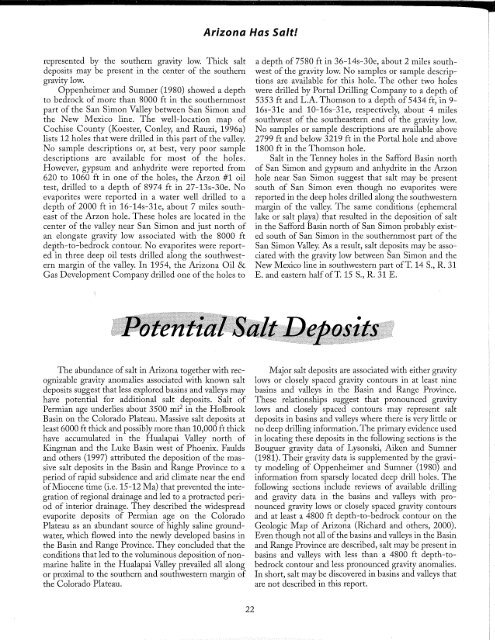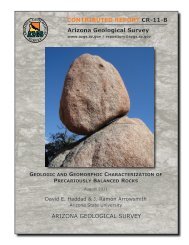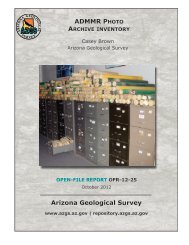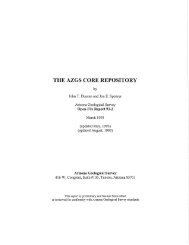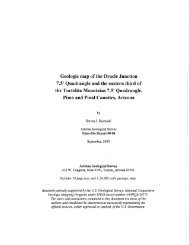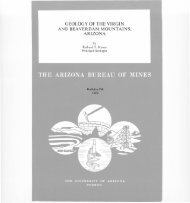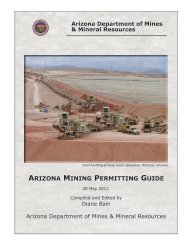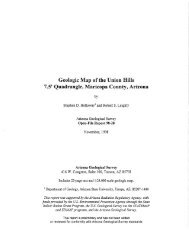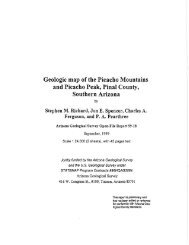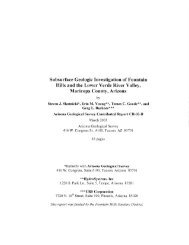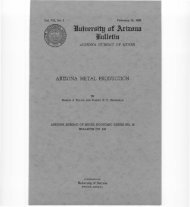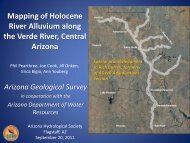Arizona has Salt! - 41 p. - AZGS Document Repository
Arizona has Salt! - 41 p. - AZGS Document Repository
Arizona has Salt! - 41 p. - AZGS Document Repository
Create successful ePaper yourself
Turn your PDF publications into a flip-book with our unique Google optimized e-Paper software.
epresented by the southern gravity low. Thick salt<br />
deposits may be present in the center of the southern<br />
gravity low.<br />
Oppenheimer and Sumner (1980) showed a depth<br />
to bedrock of more than 8000 ft in the southernmost<br />
part of the San Simon Valley between San Simon and<br />
the New Mexico line. The well-location map of<br />
Cochise County (Koester, Conley, and Rauzi, 1996a)<br />
lists 12 holes that were drilled in this part ofthe valley.<br />
No sample descriptions or, at best, very poor sample<br />
descriptions are available for most of the holes.<br />
However, gypsum and anhydrite were reported from<br />
620 to 1060 ft in one of the holes, the Arzon #1 oil<br />
test, drilled to a depth of 8974 ft in 27-13s-30e. No<br />
evaporites were reported in a water well drilled to a<br />
depth of 2000 ft in 16-14s-31e, about 7 miles southeast<br />
of the Arzon hole. These holes are located in the<br />
center of the valley near San Simon and just north of<br />
an elongate gravity low associated with the 8000 ft<br />
depth-to-bedrock contour. No evaporites were reported<br />
in three deep oil tests drilled along the southwestern<br />
margin of the valley. In 1954, the <strong>Arizona</strong> Oil &<br />
Gas Development Company drilled one ofthe holes to<br />
The abundance ofsalt in <strong>Arizona</strong> together with recognizable<br />
gravity anomalies associated with known salt<br />
deposits suggest that less explored basins and valleys may<br />
have potential for additional salt deposits. <strong>Salt</strong> of<br />
Permian age underlies about 3500 mi 2 in the Holbrook<br />
Basin on the Colorado Plateau. Massive salt deposits at<br />
least 6000 ft thick and possibly more than 10,000 ft thick<br />
have accumulated in the Hualapai Valley north of<br />
Kingman and the Luke Basin west of Phoenix. Faulds<br />
and others (1997) attributed the deposition of the massive<br />
salt deposits in the Basin and Range Province to a<br />
period ofrapid subsidence and arid climate near the end<br />
ofMiocene time (i.e. 15-12 Ma) that prevented the integration<br />
ofregional drainage and led to a protracted period<br />
of interior drainage. They described the widespread<br />
evaporite deposits of Permian age on the Colorado<br />
Plateau as an abundant source of highly saline groundwater,<br />
which flowed into the newly developed basins in<br />
the Basin and Range Province. They concluded that the<br />
conditions that led to the voluminous deposition ofnonmarine<br />
halite in the Hualapai Valley prevailed all along<br />
or proximal to the southern and southwestern margin of<br />
the Colorado Plateau.<br />
<strong>Arizona</strong> Has <strong>Salt</strong>!<br />
22<br />
a depth of 7580 ft in 36-14s-30e, about 2 miles southwest<br />
of the gravity low. No samples or sample descriptions<br />
are available for this hole. The other two holes<br />
were drilled by Portal Drilling Company to a depth of<br />
5353 ft and L.A. Thomson to a depth of5434 ft, in 9<br />
16s-31e and 10-16s-31e, respectively, about 4 miles<br />
southwest of the southeastern end of the gravity low.<br />
No samples or sample descriptions are available above<br />
2799 ft and below 3219 ft in the Portal hole and above<br />
1800 ft in the Thomson hole.<br />
<strong>Salt</strong> in the Tenney holes in the Safford Basin north<br />
of San Simon and gypsum and anhydrite in the Arzon<br />
hole near San Simon suggest that salt may be present<br />
south of San Simon even though no evaporites were<br />
reported in the deep holes drilled along the southwestern<br />
margin of the valley. The same conditions (ephemeral<br />
lake or salt playa) that resulted in the deposition of salt<br />
in the Safford Basin north of San Simon probably existed<br />
south of San Simon in the southernmost part of the<br />
San Simon Valley. As a result, salt deposits may be associated<br />
with the gravity low between San Simon and the<br />
New Mexico line in southwestern part ofT. 14 S., R. 31<br />
E. and eastern half ofT. 15 S., R. 31 E.<br />
Major salt deposits are associated with either gravity<br />
lows or closely spaced gravity contours in at least nine<br />
basins and valleys in the Basin and Range Province.<br />
These relationships suggest that pronounced gravity<br />
lows and closely spaced contours may represent salt<br />
deposits in basins and valleys where there is very little or<br />
no deep drilling information. The primary evidence used<br />
in locating these deposits in the following sections is the<br />
Bouguer gravity data of Lysonski, Aiken and Sumner<br />
(1981). Their gravity data is supplemented by the gravity<br />
modeling of Oppenheimer and Sumner (1980) and<br />
information from sparsely located deep drill holes. The<br />
following sections include reviews of available drilling<br />
and gravity data in the basins and valleys with pronounced<br />
gravity lows or closely spaced gravity contours<br />
and at least a 4800 ft depth-to-bedrock contour on the<br />
Geologic Map of <strong>Arizona</strong> (Richard and others, 2000).<br />
Even though not all ofthe basins and valleys in the Basin<br />
and Range Province are described, salt may be present in<br />
basins and valleys with less than a 4800 ft depth-tobedrock<br />
contour and less pronounced gravity anomalies.<br />
In short, salt may be discovered in basins and valleys that<br />
are not described in this report.<br />
i


